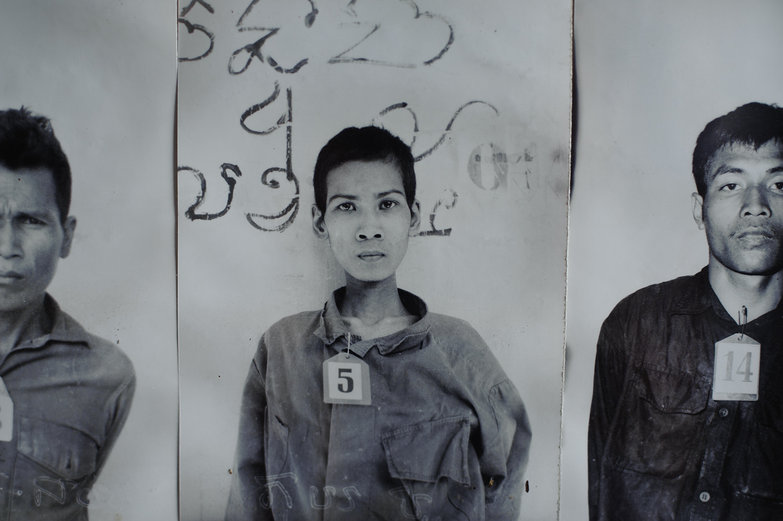This afternoon, we are going to learn about Cambodian history – specifically the horrific genocide led by Pol Pot in the late seventies. As we roll up to the entrance of Tuol Sleng (Strychnine Hill or Hill of the Poisonous Tree), the Khmer Rouge's interrogation and extermination prison, we're drenched in sweat from our brief ride in the hot afternoon sun.
Steeling ourselves for a depressing day, we leave our bikes with the parking attendant, buy tickets, and head to one of the several buildings that make up the prison complex. This structure is filled with photographs of the thousands of people imprisoned here over the years, including many women and children.

With haunting eyes and expressions evoking every emotion from hopelessness to defiance, the display of victims is poignant and heart-wrenching. We learn that every single person admitted into the prison was documented and photographed for the Khmer Rouge's meticulous records.
It is so disturbing to me to think about the meticulous care taken in cataloging these people, in contrast with the brutal heartlessness with which they were murdered.
Out of an estimated 17,000 people imprisoned at Tuol Sleng, there were only seven known survivors.

After the photograph-filled building, we head into a block of what look like barracks. These are the prison cells, most with empty beds and shackles still in place. It's quiet and echoey, run down, and a little eerie. Though the Khmer Rouge stripped the building of any redeeming qualities with its horrifying activities, the stair case still reminds me of its former use as a high school.
Surprisingly, though the actual prison and the time of Pol Pot's regime were full of horrors, the exhibits at Tuol Sleng aren't as emotionally draining as we expected them to be. It won't be until weeks later that we'll learn the truth from our friends: somehow we missed out on many of the more informative exhibits.
The torture system at Tuol Sleng was designed to make prisoners confess to whatever crimes they were charged with by their captors. Prisoners were routinely beaten and tortured with electric shocks, searing hot metal instruments and hanging, as well as through the use of various other devices.
Tuol Sleng Genocide Museum, Wikipedia

Some prisoners were cut with knives or suffocated with plastic bags. Other methods for generating confessions included pulling out fingernails while pouring alcohol on the wounds, holding prisoners’ heads under water, and the use of the waterboarding technique. The "Medical Unit" at Tuol Sleng, however, did kill at least 100 prisoners by bleeding them to death.
Tuol Sleng Genocide Museum, Wikipedia
While it would have been enlightening to read more about the history and horrors of the Khmer Rouge and Pol Pot's regime, I'm not entirely sure I'm upset we missed the other exhibits. The truth is bitter and hard to stomach sometimes.



